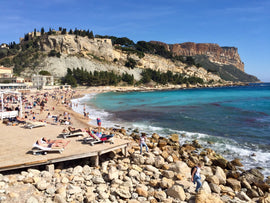Though we often associate winemaking with tradition and continuity, frequently featuring indigenous varietals farmed for centuries on local soils, the history of the craft is stippled with chance and change, iconoclasts and happy accidents, and grapes escaping their native regions and finding purpose on distant dirt. In May, we explored the world of old vines; this month we are focusing on newer growths with two wineries, Chateau de Campuget of southern France and Forge Cellars in upstate New York, that farm some extremely distinctive varietals far from their points of origin.
Saperavi is the primary indigenous red varietal of Georgia, the small Caucasus nation that can most credibly claim to have invented winemaking. In 2017 archeologists unearthed 8,000 year old jars outside the capital Tbilisi, bearing traces of wine compounds - and images of grape clusters and a man dancing - that constitute the earliest evidence of specifically wine-related viticulture. While it’s not known exactly which grapes these ancient visionaries cultivated, Saperavi roots start here, and its longevity is due to its quite specific properties. Saperavi (literally ‘dye’ in Georgian) is one of the few teinturier grapes in the world, meaning that both its skins and interior flesh are red (most red wine grapes are translucent inside and derive their color from the red skin). It is sometimes used as a blending grape for color, and on its own it produces full-bodied, opulently flavored, high-acid reds. It also thrives in extreme, inhospitable climate conditions, such as the chilly, high altitude, inland Kakheti region in Georgia, where most of it is grown. An odd match perhaps for hot and coastal Southern France, but in 2013, almost on a whim, Frank-Lin Dalle of Chateau Campuget planted two hectares on his estate, and has been producing France’s only Saperavi ever since. Campuget is located in the Costières de Nîmes AOC, which the southernmost appellation in the Rhone Valley, but it’s proximity to the Rhone river delta and Medditereanen Sea result in some of the coolest temperatures in the region, and the large diurnal temperature shifts help preserve acidity and purity of fruit in the wines. Dalle’s Saperavi retains the distinguishing characteristics of the varietal - a deep, dark hue, big flavors and bold tannins - but foregrounds a freshness for which Costières de Nîmes is known; it is lusher, more generous and less astringent than its Georgian inspirations, and ready to drink now.
Formed 20,000 years ago through a series of glacial advances and retreats, New York’s Finger Lakes consist of eleven long, slender digits that extend north to south between and below Rochester and Syracuse. Following the pioneering mid-century efforts of Ukranian plant scientist Dr. Konstantin Frank, who successfully grafted European Vitis Vinifera varieties onto hardy, native rootstock, the Finger Lakes became an American Viticultural Area (AVA) in 1982. Today there are 100 wineries and 11,000 hectares under vine in the region, most of which are located on the slopes overlooking the two largest and deepest lakes, Cayuga and Seneca; both of which have since achieved their own AVA subregion status. While a number of varietals (including Saperavi!) are cultivated in the Finger Lakes, it is primarily known for producing world-class Riesling. Age-worthy, complex and extremely terroir-sensitive, Riesling, which is native to the Rhine region in Germany, is capable of creating great sparkling, bone-dry, semi-sweet and dessert wines (and everything in between.) These protean qualities align ideally with the plethora of microclimates and diverse arrangement of soils generated and sustained by the Finger Lakes’ deep expanses of water. In 2008, intrigued by the possibilities, Rhone wine legend Louis Barroul (of Chateau St. Cosme fame) and American wine distributor Richard Rainey founded Forge Cellars. They released their first vintage in 2011, and remain a small production endeavor (4,000 cases annually) with sizable ambitions. In 2019, they produced 11 different single vineyard dry Rieslings from the slopes of Seneca Lake; we tasted through them all and were blown away by the quality and distinctiveness of each. Any one would’ve been a fine choice for this month’s club but the Caywood Vineyard bottling stood out for it’s balance, complexity and sheer drinking pleasure.
Cheers,
The PlumpJack Wine Team
|
Château de Campuget 1753 Saperavi Sans Soufre 2019 |
|
|
Region / Country of Origin: Costières de Nîmes, France |
About the winery: Château de Campuget was established in 1942 and is a top quality estate near Nîmes, steeped in history. The Château itself was built in 1753 and the first vines were planted at the same time, prompting the 1753 range of wines which mark this historic date. Franck-Lin Dalle represents the third generation of his family to make wine for Campuget. In 2019, Château de Campuget was certified as Haute Valeur Environmentale, which officially recognizes the environmental performance of winegrowers, including biodiversity conservation, plant protection strategies, managed fertilizer use and water resource management. About the winemaking: Fermented in stainless steel vats using a very traditional technique. After a maceration period of around 15 days to 3 weeks, the juice and marc (residue) are separated after having been pressed pneumatically. No sulfites are added during the production process and the wine is vegan; fining is done with vegetable proteins and mineral products. 1500 cases produced. Tasting Notes: On the nose, the expression of morello cherry is surprising. On the palate, the tannins are supple, rich, and powerful. Finally, precise and rigorous aging made it possible to retain in the wine all its freshness, a guarantee of long aging. A surprising grape variety, a real discovery. |
|
Winemaker: Franck-Lin Dalle |
|
|
$23 bottle/ $/$248.4 case |
|
|
Suggested Food Pairing: Pan roasted pork tenderloin Barbecue pork Roasted mushrooms |
|
|
2019 Forge Caywood Vineyard Dry Riesling |
|
|
Region / Country of Origin: Finger Lakes AVA, New York |
About the Winery: Louis comes from a winemaking tradition of 14 generations; he grew up among the vines and took over the estate from his dad in 1992, proceeding to improve quality and grow a vigneron-negociant arm of the business. Chateau de St. Cosme is now regarded as the benchmark of wine quality in Gigondas. Meanwhile, Louis is at the helm of Forge Cellars in both winemaking and management, bringing an immense amount of practical experience and knowledge into every aspect of the project. About the winemaking: Caywood Vineyard is a living, breathing museum. This collection of vines was planted without clonal selection in the early 1970s by Charles Fournier. Picked Oct. 18-19 Hand-harvested, sorted, and whole cluster pressed. Fermented with indigenous yeasts in the barrel. 300 cases produced. Tasting Notes: The expression of Caywood Riesling is constantly evolving, yet the wine continues to retain a signature profile dominated by herbs and spices. Nose has notes of orange blossom, while the palate is structured by good acidity, with notes of green apple and lemon undergirded by a nutty, saline minerality. |
|
Winemaker: Louis Barroul |
|
|
$26 bottle / $280.8 case |
|
|
Suggested Food Pairing: Baked lemon pepper sea bass Spicy shrimp and cellophane noodle salad Oven roasted root vegetables |
|
Find similar articles
Clubs



